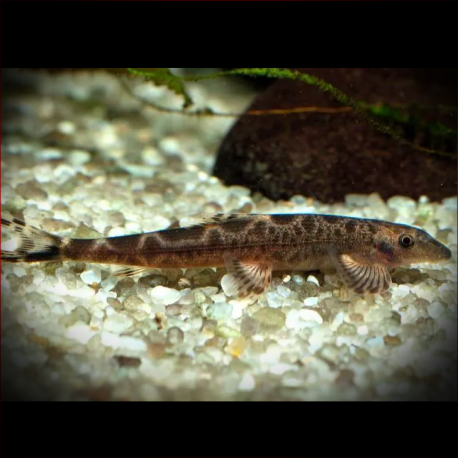More info
Datasheet
| Minimum Tank Size | 96 litres / 25.36 US gallons |
| Maximum Size | 7.0cm / 2.76inches |
| Temperature | 68°C / 154.40°F - 78°C / 172.40°F |
| Hardness | 1.01dgH / 18ppm - 12.05dgH / 215ppm |
| pH | 6.0-7.5 |
General Description:
Pseudohomaloptera Leonardi, formerly known as Homaloptera sp. 'H01,' is a species of fish belonging to the family Balitoridae within the order Cypriniformes. They are often referred to as "lizard" loaches due to their peculiar behavior and appearance. These fish have specialized morphology adapted for life in fast-flowing water, with horizontally extended paired fins, flattened head and body, and a depressed belly enabling them to cling tightly to solid surfaces.
Aquarium Setup:
For keeping Pseudohomaloptera Leonardi in captivity, it is essential to set up a well-oxygenated tank with clean water. An over-sized filter with a turnover of 10-15 times per hour is recommended. The base substrate can consist of gravel, sand, or a mixture of both, along with water-worn rocks and pebbles. Driftwood roots, branches, and aquatic plants such as Microsorum, Crinum, and Anubias spp. can be added to create a suitable environment. The tank should be biologically mature, and a secure cover is necessary as these fish can climb glass.
Behaviour:
While not aggressive, Pseudohomaloptera Leonardi is reclusive in nature. They prefer the company of conspecifics and are not particularly territorial towards them. Suitable tankmates include species like Danio, Devario, Rasbora, gobies, and specific catfish varieties. However, harmless squabbles may occur, especially with some loaches from the Balitoridae family.
Feeding and Diet:
In the wild, Pseudohomaloptera Leonardi feeds on biofilm, small crustaceans, insect larvae, and other invertebrates. In captivity, they may accept sinking dried foods, but regular live or frozen meals of Daphnia, Artemia, bloodworms are crucial for their health. These fish benefit from algae growth and aufwuchs on solid surfaces in the tank and should be provided with a constant source of suitable foods to thrive.
Reproduction & Dimorphism:
While presumed to be seasonal spawners in their natural habitat, there is no recorded information about the breeding behavior of Pseudohomaloptera Leonardi in aquarium settings. Sexually mature females are slightly larger and fuller-bodied than males.
Habitat and Distribution:
Pseudohomaloptera Leonardi is typically found in swiftly-flowing streams and headwaters with clear, oxygen-rich water. They prefer habitats with gravel, rocks, boulders, or bedrock covered in biofilm. Juveniles inhabit slower-moving areas with gravel substrate and submerged wood structures. The species is distributed in Peninsular Malaysia and extends into parts of Thailand; however, records from other regions like Cambodia require validation.

